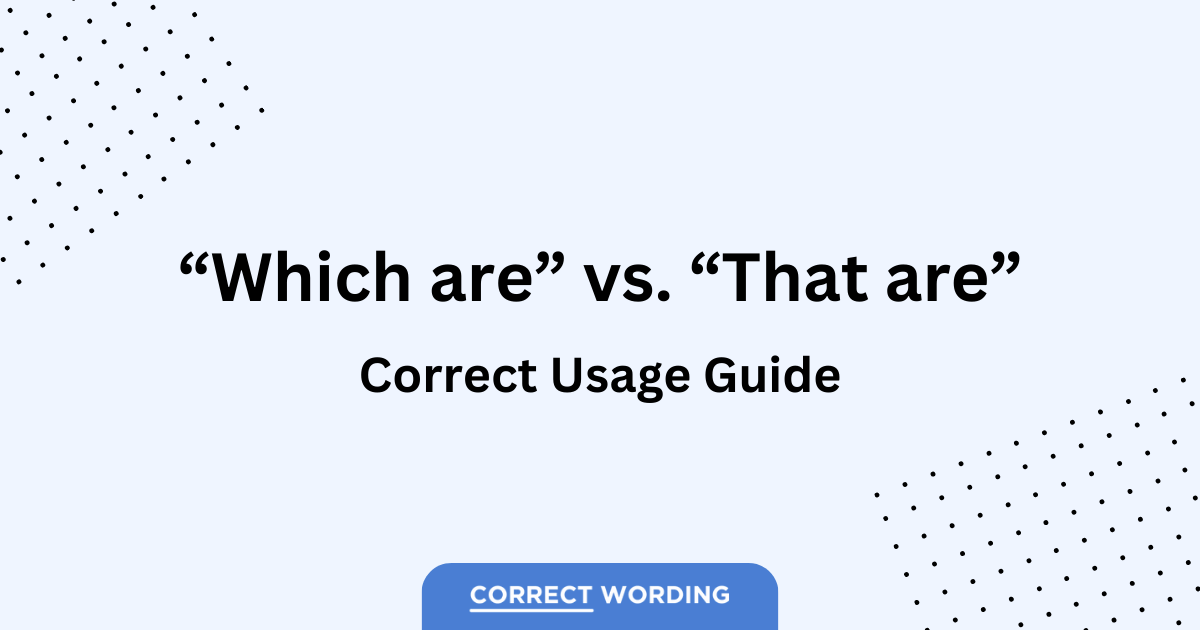“Which are” vs. “That are” – How to Correctly Use Each
“Which are” and “that are” are two phrases that can cause confusion due to their similar usage in sentences. However, they have different functions and uses. This article will guide you through the differences between these two phrases and how to use each one correctly.
Quick Summary
“Which are” and “that are” are often confused, especially in writing. “That are” is used in defining (restrictive) clauses, while “which are” is used in non-defining (non-restrictive) clauses and questions. Understanding when to use each phrase is crucial for clear and proper communication.
“Which are” vs. “That are” – Which is Correct?
Both “which are” and “that are” are correct, but they are used in different contexts. The table below provides a summary:
| Phrase | When to Use | Example |
|---|---|---|
| That are | In defining (restrictive) clauses, which provide essential information about the noun they modify | I have books that are perfect for your research. |
| Which are | In non-defining (non-restrictive) clauses, which provide additional information about the noun they modify, and in questions | I have some old novels, which are perfect for a rainy day. |
How to Use “That are”
“That are” is used in defining (restrictive) clauses. These clauses provide essential information about the noun they modify. The sentence would not make sense without this information. Here are some examples:
“I have books that are perfect for your research.” In this sentence, “that are perfect for your research” is a defining clause that tells us which books the speaker is referring to.
How to Use “Which are”
“Which are” is used in non-defining (non-restrictive) clauses, which provide additional information about the noun they modify. This information is not essential to the meaning of the sentence. “Which are” is also used in questions. Here are some examples:
“I have some old novels, which are perfect for a rainy day.” In this sentence, “which are perfect for a rainy day” is a non-defining clause that provides extra information about the novels.
“Which are the best days to visit the museum?” In this question, “which are” is used to ask for specific information.
Defining (Restrictive) Clauses vs. Non-defining (Non-restrictive) Clauses
Understanding the difference between defining (restrictive) clauses and non-defining (non-restrictive) clauses can greatly improve your sentence construction and clarity of expression. Let’s break down these terms in a way that’s easy to understand.
Defining (Restrictive) Clauses
Defining clauses, also known as restrictive clauses, are parts of a sentence that provide essential information about the noun they are referring to. This information is necessary for the meaning of the sentence. If you remove a defining clause, the sentence would lose a significant part of its meaning, or it might become unclear.
For instance, consider the sentence: “The books that are on the top shelf are mine.” Here, “that are on the top shelf” is a defining clause. It tells us exactly which books the speaker is referring to – the ones on the top shelf. Without this clause, the sentence would be “The books are mine,” and we wouldn’t know which books the speaker is talking about.
Non-defining (Non-restrictive) Clauses
On the other hand, non-defining clauses, also known as non-restrictive clauses, add extra information to the sentence. This information, while interesting or useful, is not essential to understand the basic meaning of the sentence. If you remove a non-defining clause, the sentence still makes sense, and its fundamental meaning doesn’t change.
For example, look at the sentence: “My brother, who is an engineer, just bought a new car.” The clause “who is an engineer” is a non-defining clause. It provides extra information about the speaker’s brother, but it’s not essential. If we remove this clause, the sentence becomes “My brother just bought a new car,” which still makes perfect sense.
In writing, non-defining clauses are usually set off by commas, while defining clauses are not. This is another easy way to tell them apart.
Practice Exercises
Test your understanding with these exercises. Fill in the blanks with “which are” or “that are”:
- I prefer restaurants ___ quiet and cozy.
- She has a collection of vintage cars, ___ worth a lot of money.
- ___ the main ingredients in this recipe?
- He loves songs ___ meaningful and deep.
- The team has players, ___ highly skilled and experienced.
Answer Key:
- That are
- Which are
- Which are
- That are
- Which are
Conclusion
Understanding the difference between “which are” and “that are” is crucial for clear and effective communication.
“That are” is used in defining (restrictive) clauses, which provide essential information about the noun they modify, while “which are” is used in non-defining (non-restrictive) clauses, which provide additional information about the noun they modify, and in questions.
Despite their similar usage, their functions are quite different. Regular practice and attention to their usage in context will help in mastering their correct application.


